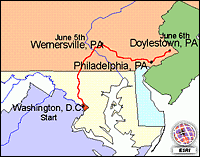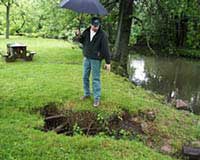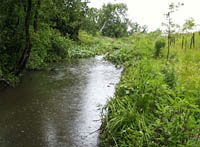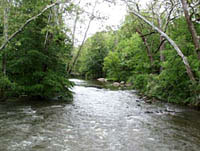|
作者:Amy Souers
06.06.2000,星期二,賓州,度麗斯城
德拉瓦河是紐約與賓州,賓州與新澤西州,以及新澤西與德拉瓦州的邊界。

由於位於這許多州的邊界,所以很難界定誰真的照料這條河。民間團體「遺產保育(Heritage Conservancy)」的工作人員Russ Johnson說,德拉瓦河是一條「可能輕易地被忽略掉」的河川。但Russ要確保這種事情絕不會發生。今天,他載著我穿越整個河谷,引領我看一些這個團體的復育計畫。

Russ Johnson指出Park Creek沿岸的侵蝕問題
我們的第一站是Park Creek,一條最後匯入德拉瓦河的小溪。這條溪已受到侵蝕與沉積的危害,所以今年春天,「遺產保育」和附近小鎮復育了一段溪岸。Russ解釋道,首先,他們必須重新把河岸整修出較自然的坡度。然後,他們以能為生物分解的椰子纖維與一些用椰子皮所做成的「木樁」來穩定河岸,以防範更嚴重的侵蝕。最後,他們種植本土草類與灌木,在草墊分解之後,可維持自然的穩定作用。
在我們的下一站 - Martin's Creek,我們看見了Park Creek未來一年內將會轉變成的新貌。去年,這裡展開一項類似的復育計畫,而現在當地的本土植物長得蒼翠繁茂(而今天下了一整天的雨,讓每樣東西看起來特別鮮綠)。
Russ載著我穿越河谷時,他指出了他所稱的「啟動城堡」 - 一些突然從曾是農田土地中冒出來的又大又新的獨棟家庭式房屋。當流域裡擁有更多的開發、道路與停車場時,水的品質就會下降。Russ告訴我,當水質下降百分之五到百分之十時,稀有或瀕臨絕跡的物種就會消失。當水質降低百分之二十五到百分之三十,大部分的本土物種就會消失。

復育一年之後的Martin's Creek
在河岸上種植緩衝帶 - 沿著溪岸種植一行行的草、灌木與樹林 - 對於保持高品質水質與保護本土魚類、鳥類與野生動物助益很大。這些緩衝帶不只防止侵蝕,他們還可以過濾污染物,並保護好的棲地。
Russ說,除了處理所有開發議題之外,他還面臨一個大問題:並不是所有人都知道「流域」是什麼。「大部分的人都知道他們住在哪一個學區裡。所以難道人們不該知道他們住在哪一個流域裡嗎?他們不該知道他們住在哪一個水源管理區裡嗎?」他懷疑。他認為,如果我們能從紐西蘭學到一課,也未嘗不是件好事 - 這個國家以流域界線為基礎,來重新配置行政界線。
Russ希望能繼續進行的其他荒野與景觀規劃地區,是德拉瓦河下游與莫斯康尼空河(Musconetcong River)。在老瑞吉紙廠的河堤上,我們遇到了莫斯康尼空河流域協會 (Musconetcong Watershed)的John Brunner,然後駛上蜿蜒的道路,穿過瑞吉小鎮。John,一位熱心的獨木舟駕駛者,說這條當地人稱為「麝香」的河流「小而強悍」。他告訴我們這條河的名字源自"Lenape",意思是"流動的水"。我們通過幾處老工廠,這些工廠是河流歷史與工業發展的見證。這條河流很受釣者歡迎 - 這地區的石灰岩地形很適合釣鱒魚和划船。

Musconetcong River,匯入德拉瓦河的支流
「荒野與景觀河川法案不只是為原始的西部河川而設計,」John說,「它也是為了保護文化與歷史價值而設立的。」
我們走出車子,站在許多橫越河流的小小的、只容單行的橋樑中的一條小橋上。水很淺,但在我們的腳下湍急地流。在大學中主修音樂的John,正在解釋他如何開始從事流域保護的工作。他說其實很簡單:「在河流與音樂之間,是有一條細線相連的。」
Amy Souers是華盛頓特區「美國河川」的網站編輯。她正在進行為期兩個月的橫越美國道路之旅,以探查美國的河川。
原文與圖片詳見: http://www.gristmagazine.com/grist/week/my week/sourers/000600.stm
版權歸屬 Earth Day Network,環境信託基金會 (謝洵怡 譯,李玲玲審校 )
中英對照全文:http://news.ngo.org.tw/issue/against/against-00062301.htm
|
|
Amy Souers is online editor for American Rivers in Washington, D.C. She is on a two-month cross-country road trip exploring America's rivers.
Tuesday, 06.06.00
DOYLESTOWN, Penn.
The Delaware River forms the boundary of New York and Pennsylvania. It's also the boundary of Pennsylvania and New Jersey. And it also separates New Jersey and Delaware.
With all of these boundaries, it's hard to know who really looks after the river. Russ Johnson says the Delaware is a river "that can easily fall through the cracks." But Russ, who works for the Heritage Conservancy, is making sure that doesn't happen. Today, he drove me through the valley to show me some of the Conservancy's restoration projects.
Russ Johnson, pointing out erosion problems along Park Creek.
Our first stop was Park Creek, a small stream that eventually feeds into the Delaware. The creek had been suffering from erosion and sedimentation, so this spring the Conservancy and the township restored a section of stream bank. Russ explained that first they had to resculpt the bank into a more natural slope. Then, they stabilized the bank to prevent further erosion using biodegradable coconut fiber mats and a "log" made of coconut husks. Finally, they planted native grasses and shrubs that will remain once the mats break down.
At our next stop, Martin's Creek, we got a glimpse of what Park Creek could look like in a year. A similar restoration project happened here last year and already the native plants are lush and thick (and the rain that fell all day today made everything look especially green!).
As Russ drove me through the valley, he pointed out what he calls "starter castles" -- the big, new single family homes popping up in what was once farmland. With more development, roads, and parking lots in the watershed, water quality diminishes. Russ told me that when the water quality goes down 10 to 15 percent, you lose rare and endangered species. And when it drops 25 to 30 percent, most native species disappear.
Martin's Creek, one year after restoration.
Planting riparian buffer strips -- those swaths of grasses, shrubs, and trees along stream banks -- can go a long way toward keeping water quality high and protecting native fish, birds, and wildlife. These buffer strips not only prevent erosion, they filter out pollutants and provide good habitat.
Russ said that in addition to dealing with all of the development issues, one big problem he faces is that not everyone knows what a "watershed" is. "Most people know what school district they live in. So shouldn't people also know what watershed they live in? Shouldn't they know what water management district they live in?" he wonders. He doesn't think it would be such a bad idea if we took a lesson from New Zealand -- that country rearranged its political lines based on watershed boundaries.
Other wild and scenic designations Russ hopes to move forward are the lower Delaware River and Musconetcong River. We met John Brunner of the Musconetcong Watershed Association on the riverbank at the old Riegels paper mill site, then drove up winding roads through the little town of Riegelstown. John, an avid canoeist, said the river, known locally as the "Musky," is "little but strong." He told us the river's name comes from the Lenape, meaning "moving water." We passed several old mills, evidence of the river's historic and industrial legacy. The river is popular with anglers -- the limestone in the area makes for good trout fishing -- as well as paddlers.
The Musconetcong River, tributary to the Delaware.
"The Wild and Scenic Rivers Act isn't just for pristine Western rivers," John said. "It also exists to protect cultural and historic values."
We got out of the car and stood on one of the many little single-lane bridges that cross the river. The water was shallow but quick under our feet. John, a music major in college, was explaining how he ended up in the watershed-protection business. He said it was actually pretty simple: "There's a thin line between rivers and music." |
